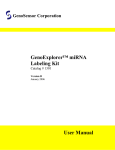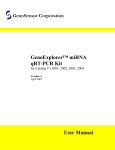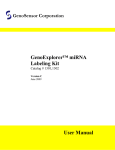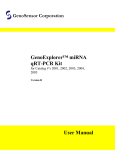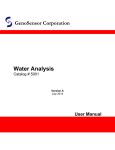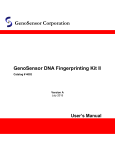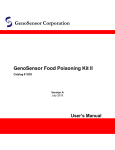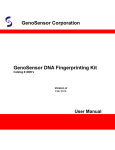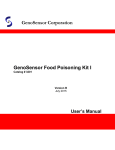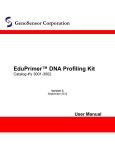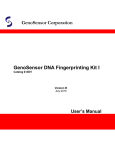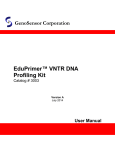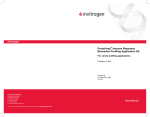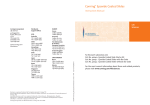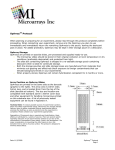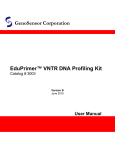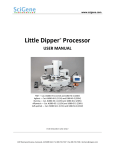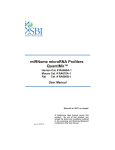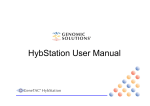Download User Manual
Transcript
GenoSensor Corporation GenoExplorer™ miRNA Biochips Kit Catalog #’s 1201-99 Version B January 2006 User Manual GenoExplorer™ microRNA Biochips Kit Table of Contents Product Overview………………………………………………………………………...... 2 Kit Components and Storage Condition …………………………………………………... 3 Additional Required Materials ……………………………………………………………. 4 Related Products from GenoSensor ……………………………………………………….. 4 GenoExplorer™ miRNA Biochip Hybridization Assay Guidelines .................................... 5 Appendix ............................................................................................................................ 8 Troubleshooting ................................................................................................................... 8 Technical Service .................................................................................................................. 10 Literature Citation When describing a procedure for publication using this product, we would appreciate that you refer to it as the GenoExplorer™ miRNA Biochips Kit. Patents and Trademarks GenoExplorer is a trademark of GenoSensor. The GenoExplorer™ miRNA Biochips Kit is covered by patents pending. 1 GenoExplorer™ microRNA Biochips Kit Product Overview GenoExplorer™ Biochips Comprehensive Probe Content GenoExplorer™ chips consist of probes for all miRNAs as registered and annotated in the miRBase at The Wellcome Trust Sanger Institute. A key differentiator of the GenoExplorer™ chip’s content is the inclusion of probes for precursor miRNA as well as mature miRNA. The content also includes probes for positive controls (e.g., 5S rRNA, tRNAs, U6) as well as negative controls. Customizable Chip Formats GenoExplorer™ chip products come in several formats. Check our website for updates on the species-specific chips available. Orders of other species are also available upon request. 3-D Gel Matrix for Optimal Hybridization Environment The surface of the GenoExplorer™ chip is composed of a 3-D gel matrix which provides a more optimal hybridization environment by extending the probe into the solution and increasing its access to the target. 2 GenoExplorer™ microRNA Biochips Kit Kit Components and Storage Conditions GenoExplorer™ miRNA Full Kit (20 reactions) Components Array Chip 2x Hyb Buffer Array Layout CD User’s Manual Amount 5 x 4 chips 5 x 280 µl 1 1 Storage +4º C +4º C Shipping and Storage GenoExplorerTM biochips and hybridization reagents are shipped at room temperature. Components should be stored at temperatures shown in the above table. At proper storage conditions, components are stable for 1 year from the date received. Expiration dates are also noted on the tube labels of each component. Safety Warnings and Precautions For research use only. Not recommended or intended for the diagnosis of disease in humans or animals. Do not use internally or externally in humans or animals. Consider all chemicals as potentially hazardous. Only persons trained in laboratory techniques and familiar with the principles of good laboratory practice should handle these products. Wear suitable protective clothing such as laboratory overalls, safety glasses, and gloves. Exercise caution to avoid contact with skin or eyes: if contact should occur, wash immediately with water (Material Safety Data Sheet for products is available upon request). 3 GenoExplorer™ microRNA Biochips Kit Additional Required Materials Recommended: GenoExplorer™ miRNA labeling kit Recommended: GenoExplorer™ reagents for hybridization assay Total RNA containing the small RNA RNase-free water Adjustable pipettors RNase-free tips RNase-free polypropylene microcentrifuge tubes (0.2, 0.5 or 1.5 ml) Graduated cylinder Microcentrifuge Incubator set at 37º C Incubator or heating block set at 75º Heating block at 95º C Hybridization Station (optional), for automated hybridization (e.g., Genomic Solutions, Tecan) or Coverslips, for manual hybridization (e.g., Erie LifterSlips™ , Product # 22x30I-2-4374) Slide Chamber, for manual hybridization (e.g., Corning® Microarray Hybridization Chamber, Product #2551) Incubator or water bath set at 42º C, for manual hybridization 50 ml screw-top tubes, for manual post-hybridization and post-stain washing Bottles for storing diluted Wash Buffers Centrifuge or air blower Microarray scanner and Image Processing Software The GenoExplorer™ Biochips kit is open to a variety of equipment. The examples given are only suggestions rather than specific recommendations. Please contact technical support if you have specific questions. Related Products from GenoSensor GenoExplorer™ microRNA Full Kit GenoExplorer™ microRNA Labeling kit GenoExplorer™ microRNA Probe Set GenoExplorer™ Reagents for Hybridization Assay 4 GenoExplorer™ microRNA Biochips Kit GenoExplorer™ miRNA Biochips Hybridization Assay Guidelines General Description GenoExplorer™ biochips are built on a 1” x 3” (25 mm x 75 mm) slide. The chips are coated with patented polymers used for DNA probe attachment. The biochips covalently immobilize amine-modified DNA oligonucleotide probes for use in microarray analysis. The chips demonstrate high probe attachment efficiency and accessibility of nucleic acid targets for hybridization. Figure 1 shows the positions of the label and probe arrays on the slide. The four arrays are positioned lengthwise 15 mm from the end of the slide opposite the label and centered widthwise 10 mm from the side of the slide. The arrays area covers a length of 18 mm and a width of 4.6 mm. Human miRNA Figure 1: Array positions on the chips 18 mm 15 mm 4.6 mm 10 mm Biochip Handling and Assembly Biochips are stored in a chip container. It is recommended to wear powder-free gloves when handling the Biochips. Open the container carefully to avoid dropping slides. Hold the slide at its edges and avoid touching the side of the slide containing the probe array. The probes are on the side of the slide which faces you when reading the slide label correctly (refer to figure 1). Prepare the chips for hybridization promptly to minimize possible accumulation of dust from the air on to the surface of the arrays (even if some dust can be washed away after post-hybridization washing procedures). Use assembly methods as recommended by hybstation or hybchamber manufacturers. For automated hybridization using a hybstation, orient the chips such that the probe side is up in the chamber and the slide-end opposite the label (where the arrays are located) are next to the sample injection port. Once the hybridization solution is introduced to the chip, avoid any drying of the chips until after the final wash step. 5 GenoExplorer™ microRNA Biochips Kit Assay Guidelines The GenoExplorer™ miRNA Biochips Kit has been optimized for microarray experiments using GenoExplorer™ reagents for hybridization assay. Below are general guidelines that can be used for running the hybridization assay on GenoExplorer™ BioChips. For a detailed protocol on running GenoExplorer™ labeled miRNA on GenoExplorer™ BioChips, please consult the user manual for the GenoExplorer™ full kit. 1. Prepare the labeled RNA sample for hybridization by combining with 2x Hyb buffer and water. The volumes of each component to be added will depend on the total hybridization volume which is determined by the type of hyb chamber or coverslip that is being used. Table 2 shows the volumes of each component required for different total hybridization volumes. Table 2: Hybridization Reaction Mix Hybridation Volume (µl) 40 60 100 120 Labeled RNA (µl) 20 20 20 20 2x Hyb Buffer (µl) 20 30 50 60 Added H2O (µl) 0 10 30 40 2. Incubate the sample at 90-95º C for 5 min. 3. Cool sample by spinning down for 2 min. 4. Load the labeled RNA on to the array. Consult with the slide chamber manufacturer’s recommended protocol for further information on assembling the slide in its chamber. 5. Run the hybridization at 42º C for 16 hours (or longer). 6. For fluorescently-labeled RNA target, after hybridization the arrays can undergo posthybridization washing and drying. GenoExplorer™ labeled wash buffers are strongly recommended for the post-hybridization wash processing. These buffers have been optimized to enhance signal and reduce background. For detailed instructions on the use of these buffers, consult the user manual for the GenoExplorer™ Full Kit. 7. For GenoExplorer™ labeled miRNA containing biotin labels, please refer to the user manual of the GenoExplorer™ Full Kit for further instructions on the posthybridizaton process. Scanning and Detection Consult the scanner manufacturer instructions for laser and PMT settings. 6 GenoExplorer™ microRNA Biochips Kit Using the Grid Files The enclosed CD provides an array list in .txt file and .gal file formats. Four arrays were printed on each chip. The name and location of each chemical probe is listed and labeled in the software. Each chemical was printed in triplicate. Arrays include known microRNA probes as well as both positive and negative controls. Load the .gal files or convert the text file to the correct format that your scanner requires. Since the first chemicals on each array are positive controls, you should see them on the upper-left corner of each array, and they are in triplicate. Move the array grid until it aligns with the positive controls in the upper-left corner (Figure 2). Proceed with data computation after gridding. Figure 2: Grid and Align the Arrays 7 GenoExplorer™ microRNA Biochips Kit Appendix Troubleshooting Guide Poor Hybridization Signal Poor quality RNA samples Suboptimal amount of sample applied to microarray Improper detection strategy Signal lost by exposure to light, environmental conditions Poor biotin/ SA-S dye detection Hybridization signal “stripped” from microarray Suboptimal hybridization time • Use higher quality RNA samples • Use proper laboratory techniques when handling RNA samples • Label and hybridize more sample to microarray • Label and hybridize more sample to microarray • Verify that detection instrumentation is compatible with detection reagents • Adjust detection settings • Minimize exposure to light • Ensure that the samples have been purified and quantified properly before labeling • Ensure that the kit components have been stored properly • Ensure that the detection solution was prepared and stored properly • Ensure correct temperatures are used for each of the process steps. • Extend hybridization time 8 GenoExplorer™ microRNA Biochips Kit High Background Excess detection reagents remaining on microarray Excess sample applied to microarray Ink or marker used to identify microarray • Do not allow slides to dry out during hybridization protocol • Do not touch microarray directly or forcibly remove coverslip at any time • Quantify the amount of labeled sample and use less in hybridization • Avoid using markers or ink to identify slide; use a diamond scribe pen Dust Dust on microarray • Avoid dust from environment • Minimize exposure of the microarray to the air • Use filtered distilled water for final wash 9 GenoExplorer™ microRNA Biochips Kit Technical Service For more information or technical assistance, please call, write, fax, or email. GenoSensor Corporation 4665 S. Ash Avenue Suite G-18 Tempe, Arizona 85282 Tel: 1-480-598-5378 Fax: 1-480-755-3319 Email: [email protected] Web: www.genosensorcorp.com Limited Warranty GenoSensor is committed to providing our customers with high-quality goods and services. Our goal is to ensure that every customer is 100% satisfied with our products and our service. If you should have any questions or concerns about a GenoSensor product or service, please contact our Technical Service at [email protected]. GenoSensor warrants that all of its products will perform according to the specifications stated on the certificate of analysis. This warranty limits GenoSensor Corporation’s liability only to the cost of the product. No warranty is granted for products beyond their listed expiration date. No warranty is applicable unless all product components are stored in accordance with instructions. GenoSensor reserves the right to select the method(s) used to analyze a product unless GenoSensor agrees to a specified method in writing prior to acceptance of the order. GenoSensor makes every effort to ensure the accuracy of its publications, but realizes that the occasional typographical or other error is inevitable. Therefore GenoSensor makes no warranty of any kind regarding the contents of any publications or documentation. If you discover an error in any of our publications, please report it to our Technical Service. GenoSensor assumes no responsibility or liability for any special, incidental, indirect or consequential loss or damage whatsoever. The above limited warranty is sole and exclusive. No other warranty is made, whether expressed or implied, including any warranty of merchantability or fitness for a particular purpose. 10











